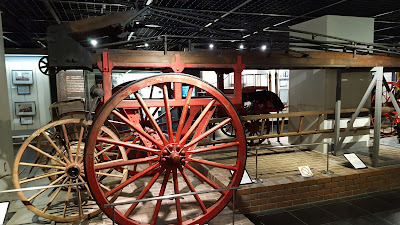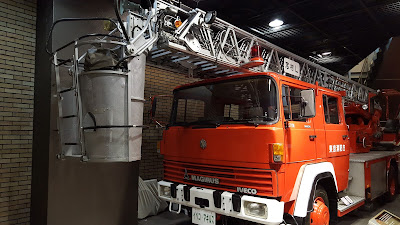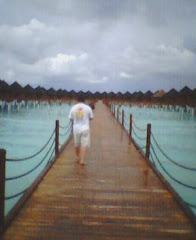Back when we lived in Tokyo, I had Saturdays and Sundays off while my wife had Sundays and Mondays off. As Saturday became my free day, I would often go out wandering around the city checking out new places - shrines and temples, parks and restaurants, and museums. I especially enjoyed going to museums that were free such as the Fire Museum in Yotsuya.
東京に住んでたころ自分の公休日は土・日。妻の公休日は日・月でした。土曜日が自分の自由の日になって良く一人で街歩きしてた。行ったことないお寺や神社、公園や飲食店そして博物館。特に好きだったのはただでエンジョイ出来る博物館。例えば四谷にある消防博物館。
The building was easy to spot. It was the one where you could see a helicopter on the roof.
ビルはとっても見つかりやすい。屋根にヘリがあるビルです。
The entrance to the building.
ビルの入り口。
A little area where kids can play.
子供たちが遊べる遊具。
A little history of firefighting in Japan.
日本の消防歴史について。
First, I decided to check out the helicopter that was on display on the roof of the building.
最初は屋根に展示されてるヘリを見に行った。
I asked a fellow visitor to take my picture.
別の訪問者に写真撮りをお願いした。
The cockpit of the helicopter.
ヘリの操縦席。
I may not have ridden in a helicopter but I can say I have been on one.
飛んでるヘリは乗ったことないが、この写真でヘリに乗ったことがあると言える。
I was like a little kid imagining what it would be like to fly one one of these puppies.
ヘリに乗って子供心になった。
I think it goes without saying that guys just like things they can drive, ride or fly even as an adult.
やっぱり男って乗り物が好きだよね。大人になっても好きです。
Time to go back inside the building to check out the various displays.
ビルの中に戻って日本の消防歴史の展示を見る。
A samurai family checking out how the hose and pump works.
侍家族が消防のホースとパンプに興味津々。
These are called matoi. They are fire brigade standards.
いろんな纏。町火消が、組の印(シンボル)として用いたが纏です。
Wheeled long box / 車長持
保険制度がなかった江戸時代、火事になると大切なものは長持に入れて運び出し、自分で守るしかありませんでした。しかし、車長持は逃げ道をふさぎ、かえって被害を大きくすることが多く、1683(天和3)以降禁止されました。~展示のサインより
Iroha No.48 (Fukagawa No.16 fire brigade's standard).
いろは48組 本所・深川16組の纏。
Firefighting helmet / 火事兜
Models of fire watchtowers.
火の見矢倉のモデルいろいろ。
Diorama of an Edo Era village.
江戸時代のジオラマ。
Horse drawn fire engine / 馬引き消防車
Firefighting motorcycle / 二輪消防車(赤バイ)
As traffic congestion became more prevalent during Japan's period of rapid growth in the 1960s, the Tokyo Fire Department deployed fire motorcycles on a provisional basis in 1969. Two years later it deployed three motorcycle officers from the Nihonbashi, Ushigome, and Koiwa Fire Stations on a full-time basis. These positions were staffed until 1976. This particular exhibit features a fire motorcycle that was used by the Hachioji Fire Station after 1976. ~courtesy of the museum sign
交通渋滞が著しいことを背景に、1969(昭和44)年暫定的に運用を開始、2年後には3台のオートバイを購入して日本橋、牛込、小岩の各消防省で正式に運用始め、1976(昭和51)年まで活躍しました。展示品は、その後配置換えになった八王子消防省のものです。~展示のサインより
Firefighting uniform / 消防服
Hand-pulled Steam Pump / 手引き蒸気ポンプ
This model was imported from England and was in use until around 1920. ~courtesay of museum sign
1909(明治42)年イギリスから購入し、1920(大正9)年ごろまで活躍したものです。~展示サインより
Gasoline-powered Pump / ガソリンポンプ
Domestically-produced gasoline-powered pumps emerged in 1912. Use of these pumps became widespread as their performance exceeded that of steam pumps and they were easier to operate. The pump on exhibit is a 1943 model. It changed from the hand pump to the steam pump, and the onearmed bandit was manufactured afterward. ~courtesy of the museum sign
1912(大正元)年、国産のガソリンポンプが開発され、蒸気ポンプよりも性能が高く、運転も簡使なため、全国に普及していました。展示されてるガソリンポンプは1943(昭和18)年製のものです。腕用ポンプから蒸気ポンプと移り変わり、ガソリンポンプが誕生した。~展示サインより
Steam-powered Pump / 蒸気ポンプ
I saved the best bit for the end of my visit. In the basement room of the building, there are different fire engines on display.
一番の見所は最後に持ってきた。ビルの地下に何台の消防車が展示されてる。
I must have spent all afternoon here as it is a six-story building and full of information and displays. And best of all - it's free!! This is a place children as well as adults can enjoy. Now I was getting hungry. I saw a gourmet burger shop on my way here, so I had already decided that that is where I was going to have lunch, but I will talk about that on my next post.
ビルも6階もあり、結構長い時間に居ました。子供から大人までが楽しめる場所と思う。そしてなによりこれがタダ!!段々おなかが空いたので、来る前に気になるバーガー屋を発見。今日そこでランチを食べに行くことを決めてたんだでもそれはまた今度話します。































































.jpg)


